Development of High-Strength, Thin Concrete Tunnel Reinforcement Method
 Load testing of reinforced
Load testing of reinforced
concrete inner lining
TEKKEN CORPORATION (President: Shiyoshi Kanda; hereafter "TEKKEN") and Kuraray Co., Ltd. (President: Yasuaki Wakui; hereafter "Kuraray"), in collaboration with the Public Works Research Institute, an incorporated administrative agency, announce the development of a new "high-strength, thin concrete tunnel reinforcement method" for the interiors of previously constructed tunnels that utilizes high-strength fiber reinforcing mortar. The new method employs mortar that contains staple fiber with high compressive strength and exceptional pliability that acts as an inner concrete reinforcing agent, combined with a fiber mesh that acts as a tension-reinforcing agent. The method utilizing a combination of these agents was developed in order to renovate and reinforce concrete lining that has deteriorated as a result of aging or geostatic pressures. The Public Works Research Institute conducted load testing on its full-size test rig, examined whether or not sufficient reinforcing effects could be obtained and established a new design and construction method.
The method employs a reinforcing layer made thinner than conventional thickness through the use of high-strength, pliable materials, enabling the reinforcement of concrete within previously constructed tunnels where limited space prevents additional layering. Construction may also be carried out in stages so that the tunnel can remain in operation while construction is in progress, which helps to lower costs and shortens the time needed to complete the process. Leveraging these characteristics, TEKKEN, Kuraray will work toward the widespread utilization of the method, primarily for reinforcing road tunnels where falling concrete and significant deterioration are concerns.
Background
Carrying out systematic and efficient maintenance and renovation work is necessary on safety grounds and to ensure that aging infrastructure can remain usable. In light of these needs, TEKKEN and Kuraray are engaged in joint research aimed at developing maintenance technologies to prolong the service lives of existing structures. The development of this new reinforcement method is the result of collaborative efforts between TEKKEN, Kuraray and the Public Works Research Institute to create an effective new method of restoring and reinforcing concrete of diminishing quality.
Overview
The new reinforcement method uses a high-strength mortar containing PVA staple fiber and a PVA filament as agents to buttress the concrete linings within tunnels. The thinness of the reinforcing layer is attributable to the use of the high-strength reinforcing mortar, which has a compressive strength of 40-60 MPa. A PVA-fiber mesh is also utilized as a tension-reinforcing agent to enhance pliability and prevent warping. Despite its thinness the reinforcing layer exhibits significant reinforcing properties, enabling its use within existing tunnels where limited space prevents additional layering.
 Diagram showing concrete inner reinforcing of existing tunnel
Diagram showing concrete inner reinforcing of existing tunnel
 Staple fiber
Staple fiber
 Fiber mesh
Fiber mesh
Applying the new method offers the following advantages.
- 1. Construction can be conducted in stages
- The method can be implemented in stages. For example, one lane of a two-lane tunnel may be utilized while the other lane is under construction, enabling traffic to flow with a minimum of disruption.
- 2. Thin reinforcing layer
- The reinforcing layer can be made thin due to the use of a fiber reinforcing mortar of exceptional strength (compressive strength: 40-60 MPa). Results of research conducted in collaboration with the Public Works Research Institute showed that a 75mm reinforcing layer had the same load-bearing performance as existing 300mm liners.
- 3. Reduction of construction costs
- The high-strength, fiber reinforcing mortar used when applying the method can be manufactured at ready-mixed concrete plants, eliminating the need for special mixing machinery at the construction site. Costs may be even further reduced, as the new method does not require the center forms that are needed with conventional reinforcing techniques.
- 4. Shorter construction times
- Construction times may be significantly shortened in comparison with previous methods for reinforcing tunnel linings because center forms are not required and because construction may be carried out in stages.
- 5. Shaping potential
- With the new method, cement board made of staple-fiber reinforcing mortar can act as embedding forms as needed. This board has exceptional impact resistance and can be readily shaped, enabling processing matched to the curved surfaces of specific tunnels. It can also be shaped easily using a sander, enabling conformity with the tunnel to which it is being applied.
- 6. Flexibility in design
- The strength of the fiber reinforcing mortar, as well as the reinforcing capacity and thickness of the fiber-mesh tension-reinforcing agent may be selected according to preferences, allowing the building of optimal reinforcing layers.
 0920 Model of two-lane tunnel: Outer diameter 9.7m (Concrete lining: t=300mm; reinforcing concrete lining: t=75mm)
0920 Model of two-lane tunnel: Outer diameter 9.7m (Concrete lining: t=300mm; reinforcing concrete lining: t=75mm)
Diagram of test conditions
 Conventional 300mm concrete lining: Load applied to conventional lining
Conventional 300mm concrete lining: Load applied to conventional lining
Deteriorated conventional 300mm concrete lining with 75mm reinforcing layer applied using the new method:
Inner concrete reinforced to undergo load testing after conventional concrete lining has been broken away
Results of large-load testing on actual tunnel
 Form board displaying its deformation performance
Form board displaying its deformation performance
